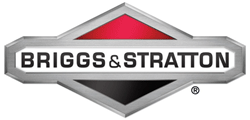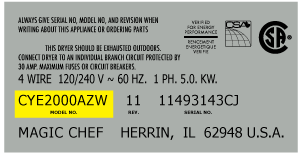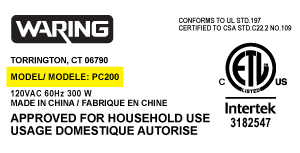11028692701 Kenmore Washer - Instructions
Keep searches simple. Use keywords, e.g. "leaking", "pump", "broken" or "fit".
Water level switch broke off in the knob.
Unplugged the washer from the power. Turned off the hot and cold water. Took two screws off the back and raised up the upper cover. Took the power cables and water tube loose from the water level switch. Removed the switch. Put the new switch in. Removed two metal clips at the top of the washer and leaned the washer body forward. Replaced the tube with a new one. Put the washer body back in place and put the clips back in. Attached the tube to the new switch along with the power cables. Let the top cover back down and put in the two screws. Slid the new knob in place. Plugged up the washer to the power. Turned the hot and cold water back on. And commenced washing laundry.
Parts Used:
-
Larry from Hyden, KY
-
Difficulty Level:Really Easy
-
Total Repair Time:30 - 60 mins
-
Tools:Screw drivers
11 of 13 people
found this instruction helpful.
Was this instruction helpful to you?
Thank you for voting!
Two problems - washer stopped and had to open and close lid several times to restart. Problem 2 - could not get inlet valve to take in hot water.
1. Read a repair manual that I bought several years ago for this model. Pictures and notes for removing control panel and back cover of washer were very helpful. Replacing the lid switch was easy as long as you have the lid open when locking it down. The control valve was easy and I swapped out wires one at a time to make sure I didn't swap hot for cold. I then removed valve and locked down new one. Reversing the control panel and back skin were easy with a second set of hands to hold the back panel in place while installing two bottom screws. The parts resolved the problems.
Parts Used:
-
Harry from Bensalem, PA
-
Difficulty Level:Easy
-
Total Repair Time:1- 2 hours
-
Tools:Nutdriver, Pliers, Screw drivers, Socket set
12 of 16 people
found this instruction helpful.
Was this instruction helpful to you?
Thank you for voting!
The wash cycle did not start.
First I removed the plastic panels on each side the control panel. Each side was secured by a phillips screw. Once the screws were removed the side panels were easily removed. I tilted the panel back to the rear of the washing machine to expose the lid switch. I first took a picture with my camera phone to ensure installing the switch correctly. I removed a small screw that secured a green ground wire. The lid switch was removed by lifting the plastic catch with a flathead (or slot) screwdriver and uplugging the switch. Reverse the steps and install the new switch. Secure and tighten the green ground wire. The lid must be lifted to properly seat the lid's guide arm into the lid switch. Replace the side panels and tighten the phillip screws. Test the wash cycle using a low water level. It took me 5 minutes to install this part. I am a attorney not a mechanic.
Parts Used:
-
Dwane from Cincinnati, OH
-
Difficulty Level:Really Easy
-
Total Repair Time:Less than 15 mins
-
Tools:Pliers, Screw drivers
10 of 11 people
found this instruction helpful.
Was this instruction helpful to you?
Thank you for voting!
tub oscillation
placed washer on side and installed new pads
and returned washer upright
and returned washer upright
Parts Used:
-
leonard from phil campbell, AL
-
Difficulty Level:Really Easy
-
Total Repair Time:15 - 30 mins
-
Tools:Pliers
12 of 17 people
found this instruction helpful.
Was this instruction helpful to you?
Thank you for voting!
washing machine not draining
Tilt machine on its side,snap off the two retaining straps and remove the pump and sanded the shaft on the electric drive motor to remove rust ,Install new pump and retaining straps and unit now running great.
Parts Used:
-
michael from princeton, TX
-
Difficulty Level:Easy
-
Total Repair Time:15 - 30 mins
-
Tools:Pliers
10 of 11 people
found this instruction helpful.
Was this instruction helpful to you?
Thank you for voting!
No cold water entering machine
After uplugging and removing the hoses from the back of the washer, 1 - Removed four screws that secure control panel to top of machine and tilted panel toward front. Disconnected wiring plugs as req'd to gain more access. 2 - Removed the two gold colored clips that secure the top to the lower sheetmetal housing and tilted the lower housing away from the back of the machine. 3 - Removed the shield that is clipped to the back just above the inlet valve assy. 4 - Removed the hose clamp from the valve, disconnected the four wires to the valve (note their position), Removed the single screw that secures the valve assy to the back and removed the valve assy. Installation is reverse of above.
Parts Used:
-
Steve from Bethel, ME
-
Difficulty Level:Easy
-
Total Repair Time:30 - 60 mins
-
Tools:Nutdriver, Pliers, Screw drivers, Wrench (Adjustable)
10 of 11 people
found this instruction helpful.
Was this instruction helpful to you?
Thank you for voting!
Replaced ring that broke and washer that was bent on the edge.
Took the agitator out and gearbox off unhook wires from motor and take off water pump, replaced the parts and put back together. Pretty easy to fix. However, I still haven't got my problem fixed. Originally the washer wouldn't spin after the rinse. I put on a new coupler and it worked for a few loads, then something smelled hot and started stinkin the house up so I opened the washer lid and smoke rolled out. Turned it off. Took the moter off and checked it and it would barely turn at all. Replaced the motor with a new one. Still wouldn't spin. Put on a new clutch assembly. Still wouldn't spin. Bought a new capacitor thinking that would do it. Still don't SPIN!!! (The ring and washer I replaced was just a casualty, not any of the problem).
Parts Used:
-
Kim from West Liberty, OH
-
Difficulty Level:Easy
-
Total Repair Time:15 - 30 mins
-
Tools:Screw drivers, Wrench (Adjustable)
22 of 47 people
found this instruction helpful.
Was this instruction helpful to you?
Thank you for voting!
spin cycle was not working / poor
Unplugged the appliance. turned off inlet water and removed hoses. popped the cap off hiding the bolt that keeps the agitator in place and pulled the agitator off. tipped the washer on its front . disconnected the Wire harness. removed the 3 bolts that hold the pump, motor,clutch, (drive assembly in other words). pulled the Drive assembly out of its resting spot removed the bad clutch and replaced it with the new one. then reassembled in reverse order.
Parts Used:
-
Craig from Plano, TX
-
Difficulty Level:Easy
-
Total Repair Time:30 - 60 mins
-
Tools:Pliers, Socket set
11 of 14 people
found this instruction helpful.
Was this instruction helpful to you?
Thank you for voting!
Washer would not wash,spin or drain.
I thought that the lid switch was the problem why the washer would not perform the drain or spin cycle. I broke the lid switch by moving the wires around. I rigged it so my daughter could use it by screwing a screw in the switch til the new one came in. After a few days, the machine stopped working again as stated above with the motor. I purchased a new Whir-pool washer for her and later found a white wire that connects to the electric motor was burnt around the connector in that only one tiny wire was still attached. I reconnected the wire in the connector and the washer started working again.
Parts Used:
-
Michael from Covington, LA
-
Difficulty Level:Really Easy
-
Total Repair Time:Less than 15 mins
-
Tools:Screw drivers
11 of 14 people
found this instruction helpful.
Was this instruction helpful to you?
Thank you for voting!
Hot water would not stop running into machine when machine is off.
Unplug machine then removed two screws from the back of the control panel so that the panel could be removed from the top of enclosure. I then removed the two spring clips that fastens the enclosure to the back panel of machine. Stand in front of machine and tilt enclosure back towards you, this opens up the machine to get access to the inlet valve. Remove all electrical wires and the water hose at the bottom of the valve. There was only one bolt that attached the valve to the back panel; remove it and replace water inlet valve.
Parts Used:
-
Jon from Lafayette, IN
-
Difficulty Level:Really Easy
-
Total Repair Time:15 - 30 mins
-
Tools:Screw drivers, Socket set
11 of 14 people
found this instruction helpful.
Was this instruction helpful to you?
Thank you for voting!
Darn thing hadn't "Agitated" for about 10 years!
After removing the bolt (7/16" head), and using a pair of pliers to remove the 3-4 in deep "cup", it was immediately obvious how to assemble the new cup and pawls (ratchets).
Orienting the black "bearing" was not so obvious, but on closer inspection of the illustration, it became clear. The four "ears" of the bearing go closest to the pawls. The little tabs that are co-planar to the ears fit into the four grooves of the new cup.
And here's the trick (besides making REALLY, REALLY SURE how the pawls orient)--Soak the black bearing piece in hot water to soften it up, and let it slide over the cup better. If you don't, you risk breaking it. If you do, it slides over and "clicjs" into place, with the ears resting right against the bottom lip of the cup, capturing the pawls.
Installation back into the washer is obvious.
The thing works like a charm! It hasn't worked this well for a decade!
Orienting the black "bearing" was not so obvious, but on closer inspection of the illustration, it became clear. The four "ears" of the bearing go closest to the pawls. The little tabs that are co-planar to the ears fit into the four grooves of the new cup.
And here's the trick (besides making REALLY, REALLY SURE how the pawls orient)--Soak the black bearing piece in hot water to soften it up, and let it slide over the cup better. If you don't, you risk breaking it. If you do, it slides over and "clicjs" into place, with the ears resting right against the bottom lip of the cup, capturing the pawls.
Installation back into the washer is obvious.
The thing works like a charm! It hasn't worked this well for a decade!
Parts Used:
-
Stephen from Cornwall, NY
-
Difficulty Level:Easy
-
Total Repair Time:Less than 15 mins
-
Tools:Pliers
10 of 12 people
found this instruction helpful.
Was this instruction helpful to you?
Thank you for voting!
Washer would not spin a full load.
!. Removed agitator from inside
2.Removed outside cabinet
3 Removed pump, motor, and transmission.
4. Slid the entire drive unit out of the tub from the bottom
5. Removed the clutch assy. and installed new.
6. Reverseed the procedure to re-assemble.
2.Removed outside cabinet
3 Removed pump, motor, and transmission.
4. Slid the entire drive unit out of the tub from the bottom
5. Removed the clutch assy. and installed new.
6. Reverseed the procedure to re-assemble.
Parts Used:
-
Ralph from Newbury Park, CA
-
Difficulty Level:Easy
-
Total Repair Time:30 - 60 mins
-
Tools:Pliers, Screw drivers, Socket set
11 of 15 people
found this instruction helpful.
Was this instruction helpful to you?
Thank you for voting!
Washer would not Agitate or spin out. Also noticed an oil leak.
I followed instructions provided from Parts Select for removing and replacing the coupler assembly, and also instructions for changing the clutch assembly. I also took it's transmission apart (socket set and flat screwdriver required), drained the old oil, cleaned it, added new 90W gear oil. The instructions covered the swapping of parts very well. Cleaning up the oil spill took as long as changing the parts.
Parts Used:
-
Jonathan from BRANDON, VT
-
Difficulty Level:Really Easy
-
Total Repair Time:More than 2 hours
-
Tools:Nutdriver, Pliers, Screw drivers, Socket set
10 of 12 people
found this instruction helpful.
Was this instruction helpful to you?
Thank you for voting!
Washer would not start adjutating unless I opened and closed the lid a few times.
Unplugged the main power. Removed the 2 screws in the back and top of the control panel. Pulled control panel forward and tipped towards me to remove from top of washer. Removed the ground wire screw with a socket/ratchet. Removed the switch by pressing the tap inwards. The tab was brittle and broke. Replaced the switch, ground wire with screw and the control panel. I notice that the 2 screws which secure the switch lever/hinge to the lid were loose. These 2 loose screws were actually the problem in the first place. The loose lever was not making good contact with the switch. I think the switch was actually fine but since I broke the tab on the switch I needed to replace it anyhow. Plugged in power cord and washed a load.
Parts Used:
-
Larry from WILLMAR, MN
-
Difficulty Level:Really Easy
-
Total Repair Time:30 - 60 mins
-
Tools:Nutdriver, Screw drivers, Socket set
10 of 12 people
found this instruction helpful.
Was this instruction helpful to you?
Thank you for voting!
Washer was leaking underneath machine
While taking apart my washing machine to clean the plastic basket I discovered the 3 main seals down the agitator were completely disintegrated and water was leaking onto the motor and onto the floor. The seals are a tight fit but slide into place easily with lubrication. When putting everything back together a bit of lubrication will be necessary as well. The leak is gone and my nearly 30 year old washer is working as well as the day it came off of the assembly line.
Parts Used:
-
RAY from DEER PARK, TX
-
Difficulty Level:Easy
-
Total Repair Time:30 - 60 mins
9 of 9 people
found this instruction helpful.
Was this instruction helpful to you?
Thank you for voting!








































